外研版高中英语选择性必修第一册Unit5 Revealing nature PeriodⅡ Using Language课件
文档属性
| 名称 | 外研版高中英语选择性必修第一册Unit5 Revealing nature PeriodⅡ Using Language课件 | 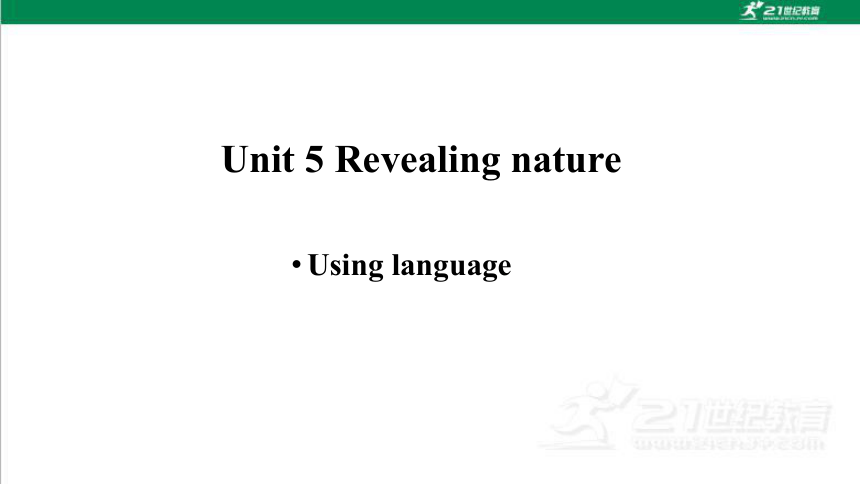 | |
| 格式 | ppt | ||
| 文件大小 | 4.9MB | ||
| 资源类型 | 试卷 | ||
| 版本资源 | 外研版(2019) | ||
| 科目 | 英语 | ||
| 更新时间 | 2025-08-06 16:10:03 | ||
图片预览

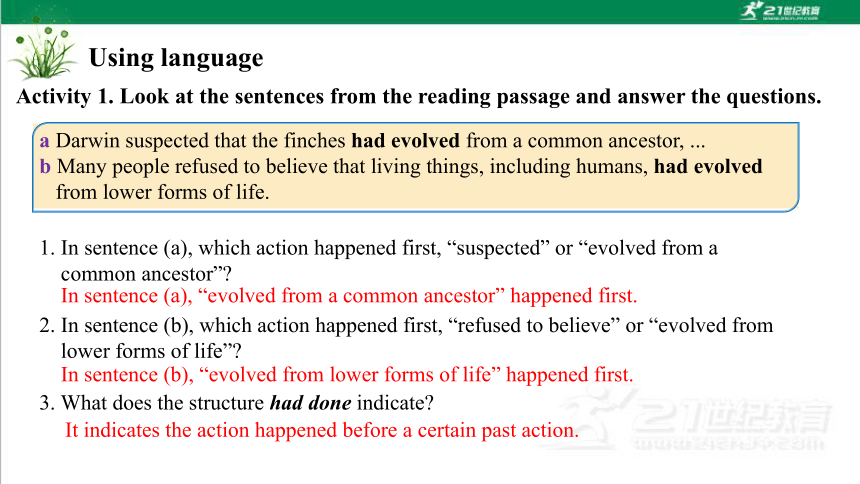

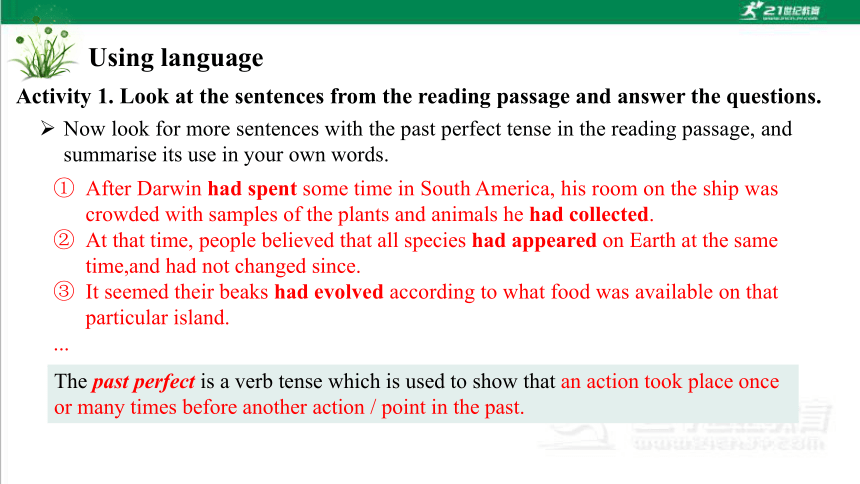
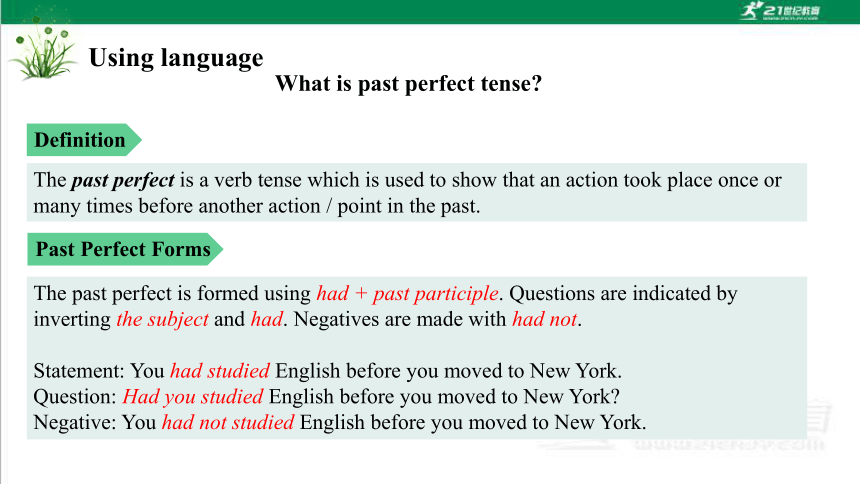
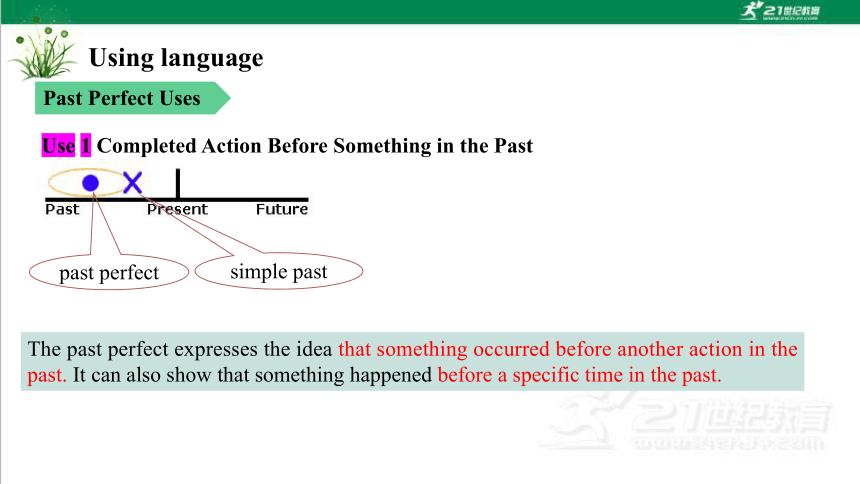

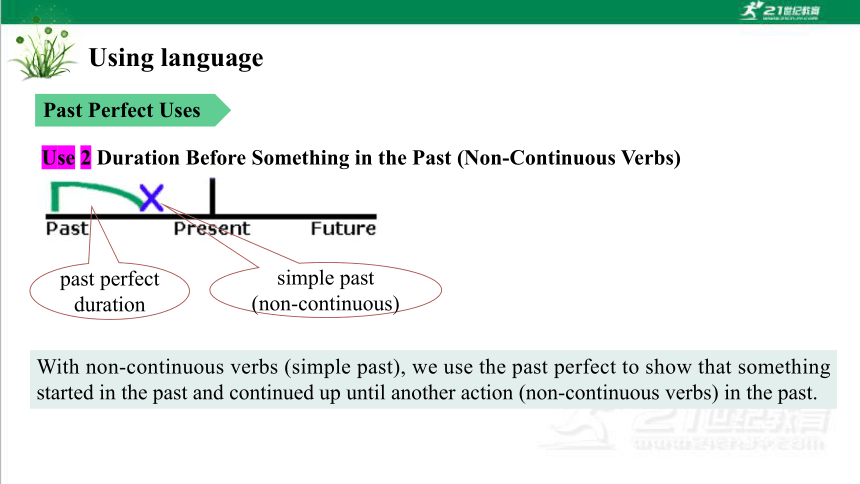
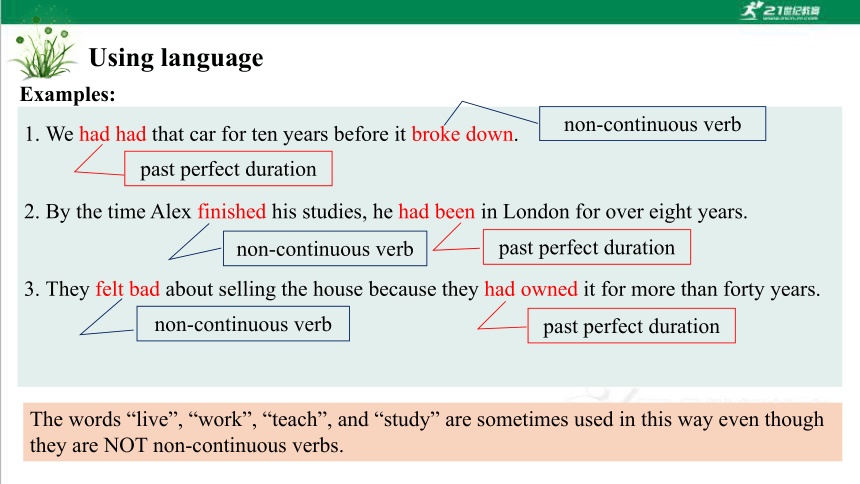
文档简介
(共24张PPT)
Unit 5 Revealing nature
Using language
1. In sentence (a), which action happened first, “suspected” or “evolved from a
common ancestor”
2. In sentence (b), which action happened first, “refused to believe” or “evolved from
lower forms of life”
3. What does the structure had done indicate
Activity 1. Look at the sentences from the reading passage and answer the questions.
a Darwin suspected that the finches had evolved from a common ancestor, ...
b Many people refused to believe that living things, including humans, had evolved
from lower forms of life.
In sentence (a), “evolved from a common ancestor” happened first.
In sentence (b), “evolved from lower forms of life” happened first.
It indicates the action happened before a certain past action.
Using language
a Darwin suspected that the finches had evolved from a common ancestor, ...
b Many people refused to believe that living things, including humans, had evolved
from lower forms of life.
In each sentence, both the two actions happened in the past, Action B happened first, Action A happened later. In this situation, past perfect is used to describe Action B and simple past is used to describe Action A.
Summary
Action A
Action B
Using language
Activity 1. Look at the sentences from the reading passage and answer the questions.
Now look for more sentences with the past perfect tense in the reading passage, and summarise its use in your own words.
After Darwin had spent some time in South America, his room on the ship was crowded with samples of the plants and animals he had collected.
At that time, people believed that all species had appeared on Earth at the same time,and had not changed since.
It seemed their beaks had evolved according to what food was available on that particular island.
...
The past perfect is a verb tense which is used to show that an action took place once or many times before another action / point in the past.
Using language
Activity 1. Look at the sentences from the reading passage and answer the questions.
The past perfect is formed using had + past participle. Questions are indicated by inverting the subject and had. Negatives are made with had not.
Statement: You had studied English before you moved to New York.
Question: Had you studied English before you moved to New York
Negative: You had not studied English before you moved to New York.
What is past perfect tense
Definition
The past perfect is a verb tense which is used to show that an action took place once or many times before another action / point in the past.
Past Perfect Forms
Using language
The past perfect expresses the idea that something occurred before another action in the past. It can also show that something happened before a specific time in the past.
past perfect
simple past
Past Perfect Uses
Using language
Examples:
1. I ____________ (not see) such a beautiful beach before I went to Kauai.
2. I did not have any money because I ________ (lose) my wallet.
3. Tony knew Istanbul so well because he ___________ (visit) the city several times.
4. ______ Susan _______ (study) Thai before she moved to Thailand
5. She only understood the movie because she _________ (read) the book.
6. Kristine _____________ (never be) to an opera before last night.
7. We were not able to get a hotel room because we ______________ (not book) in advance.
8. A: _______ you ever _______ (visit) the U.S. before your trip in 2006
B: Yes, I ____________ to the U.S. once before.
hadn’t seen
had lost
had visited
studied
Had
had read
had never been
hadn’t booked
Had
visited
had been
Using language
With non-continuous verbs (simple past), we use the past perfect to show that something started in the past and continued up until another action (non-continuous verbs) in the past.
simple past
(non-continuous)
past perfect duration
Past Perfect Uses
Using language
Examples:
1. We had had that car for ten years before it broke down.
2. By the time Alex finished his studies, he had been in London for over eight years.
3. They felt bad about selling the house because they had owned it for more than forty years.
non-continuous verb
past perfect duration
non-continuous verb
past perfect duration
past perfect duration
non-continuous verb
The words “live”, “work”, “teach”, and “study” are sometimes used in this way even though they are NOT non-continuous verbs.
Using language
Adverbs such as always, only, never, ever, still and just are usually placed between had and past participle.
Examples:
You had previously studied English before you moved to New York.
Had you previously studied English before you moved to New York
Adverb Placement in Past Perfect
Using language
Active voice: had + past participle
Passive voice: had + been + past participle
Examples:
George had repaired many cars before he received his mechanic’s license. (Active)
Many cars had been repaired by George before he received his mechanic’s license. (Passive)
Active/ Passive Voice in Past Perfect
Using language
1. a. Natural disasters led to food shortages in the 1960s.
b. Yuan Longping began to do research on hybrid rice.
c. Yuan Longping developed a better type of rice.
Yuan Longping _____________ to do research on hybrid rice because natural disasters ______________ food shortages in the 1960s. In the end, he ____________ a better type of rice.
began
had led to
developed
Activity 2. Complete the paragraphs with the information from the given sentences. The sentences are in the order in which they happened. They can help you decide the use of tenses.
Using language
Yuan Longping
Yuan Longping was born in Beijing in 1930. After he graduated from university in the early 1950s, he dedicated himself to the research of agriculture.Yuan had the idea to create a new breed of rice in the 1960s. Since then, he has worked tirelessly to research and develop a better rice breed. In 1973 he and his collaborators managed to cultivate a hybrid rice species that was superior to many others. This species produced 20 per cent more rice per plant than the commonly grown varieties. For his achievements and contributions, Yuan is known as the “father of hybrid rice” and was awarded the Medal of the Republic in 2019.
Activity 2. Complete the paragraphs with the information from the given sentences. The sentences are in the order in which they happened. They can help you decide the use of tenses.
Using language
Background information
2. a. Gregor Mendel chose to study pea plants because their characteristics
were easy to control.
b. Gregor Mendel made important discoveries about genetics.
c. Gregor Mendel died in 1884.
Gregor Mendel ___________ study pea plants because their characteristics were easy to control. By the time of his death in 1884, he ________ important discoveries about genetics.
chose to
had made
Using language
Activity 2. Complete the paragraphs with the information from the given sentences. The sentences are in the order in which they happened. They can help you decide the use of tenses.
Gregor Mendel
Gregor Mendel (1822-1884) was an influential botanist. Mendel worked out the basic principles of heredity by experimenting with plants. In 1866, he published his findings, showing how invisible “factors” (now known as genes) are responsible for predictable visible traits. As a result of his work, he became known as the “father of modern genetics”.
Activity 2. Complete the paragraphs with the information from the given sentences. The sentences are in the order in which they happened. They can help you decide the use of tenses.
Using language
Background information
compete decline eat
live introduce arrive
Lonesome George
Lonesome George was the last Pinta Island tortoise. He died in 2012. After George’s death, the Pinta Island tortoise was declared extinct.
The extinction of the Pinta Island tortoise is blamed on humans. Before humans __________ on the island, the species ___________in isolation and ___________ the plants that naturally grew there. George was discovered many years after their arrival, and by then humans ______________ new species that _________ for the food the tortoises ate. After goats in particular had been brought to the island, the Pinta Island tortoise population ____________. Eventually, only George remained.
arrived
had lived
had eaten
had introduced
competed
declined
Activity 3. Complete the online encyclopedia entry with the correct form of the words in the box.
Using language
Using language
Biodiversity
Listen to the podcast and choose the statements that are made.
1. Biodiversity is important.
2. Bacteria are always harmful to humans.
3. Some species of bacteria are used in food production.
4. Many species of bacteria recycle dead organic matter.
5. Our immune systems are able to fight off all germs.
Using language
Biodiversity
Listen again and complete the fact sheet.
Cells
Every living thing is 1. ________________.
They are like 2. ___________________________________.
In the human body there are about 3. ________________________ human cells and around 4. ____________________bacteria cells.
Bacteria
Most bacteria in the human body can 5. ___________________.
In the food production process, bacteria can 6. _______________ dead organic matter.
made up of cells
bricks that are used to build houses
thirty trillion
thirty-nine trillion
help with digestion
break down
Using language
听力原文
Using language
听力原文
Using language
Complete the boxes with the expressions from the podcast.
Do you know about... Have you heard of...
By the way, ... In fact, ...
Actually, ... Speaking of which, ...
Checking background knowledge
Adding information
Do you know about...
Have you heard of...
By the way, ... Actually, ... In fact, ... Speaking of which, ...
Using language
Read the passage on Page 54 and answer the questions.
1. What species are mentioned and what is special about them
2. What other unusual life forms do you know of
Two species are mentioned: the blue whale and the water bear. The blue whale is the largest animal species on Earth, which can grow up to almost 30 metres in length and weigh over 130,000 kilos. The water bear is probably the toughest species, which can survive temperatures from 150℃ to a below freezing -272℃.
Using language
Complete the paragraphs with the correct form of the words and expressions in the box.
The Galápagos Islands are renowned worldwide for their unique biodiversity. The Giant Tortoise Reserve on Santa Cruz 1. ________ several species of giant tortoise that 2. __________ the Galápagos
Islands. The island is also home to the Charles Darwin Research Station, where 3. __________ studies are carried out.
is home to
are native to
scientific
Mangroves are one of the coastal plants that grow on Isabela. They serve as the 4. _____________ for various birds and fish, and are very important to the 5. _______________.
habitats
ecosystem
Iguanas can be found on San Cristóbal. They have a very special
6. _________, with comb-like spines on their back. There is evidence that all the different iguanas have developed from more 7. _________
ones and share a common 8. __________.
appearance
primitive
ancestor
Work in pairs. Act out a role-play using the information in Activity 3. One of you will play the keeper of Lonesome George, and the other will play the reporter asking about George. Use the past perfect tense where appropriate.
Homework
Unit 5 Revealing nature
Using language
1. In sentence (a), which action happened first, “suspected” or “evolved from a
common ancestor”
2. In sentence (b), which action happened first, “refused to believe” or “evolved from
lower forms of life”
3. What does the structure had done indicate
Activity 1. Look at the sentences from the reading passage and answer the questions.
a Darwin suspected that the finches had evolved from a common ancestor, ...
b Many people refused to believe that living things, including humans, had evolved
from lower forms of life.
In sentence (a), “evolved from a common ancestor” happened first.
In sentence (b), “evolved from lower forms of life” happened first.
It indicates the action happened before a certain past action.
Using language
a Darwin suspected that the finches had evolved from a common ancestor, ...
b Many people refused to believe that living things, including humans, had evolved
from lower forms of life.
In each sentence, both the two actions happened in the past, Action B happened first, Action A happened later. In this situation, past perfect is used to describe Action B and simple past is used to describe Action A.
Summary
Action A
Action B
Using language
Activity 1. Look at the sentences from the reading passage and answer the questions.
Now look for more sentences with the past perfect tense in the reading passage, and summarise its use in your own words.
After Darwin had spent some time in South America, his room on the ship was crowded with samples of the plants and animals he had collected.
At that time, people believed that all species had appeared on Earth at the same time,and had not changed since.
It seemed their beaks had evolved according to what food was available on that particular island.
...
The past perfect is a verb tense which is used to show that an action took place once or many times before another action / point in the past.
Using language
Activity 1. Look at the sentences from the reading passage and answer the questions.
The past perfect is formed using had + past participle. Questions are indicated by inverting the subject and had. Negatives are made with had not.
Statement: You had studied English before you moved to New York.
Question: Had you studied English before you moved to New York
Negative: You had not studied English before you moved to New York.
What is past perfect tense
Definition
The past perfect is a verb tense which is used to show that an action took place once or many times before another action / point in the past.
Past Perfect Forms
Using language
The past perfect expresses the idea that something occurred before another action in the past. It can also show that something happened before a specific time in the past.
past perfect
simple past
Past Perfect Uses
Using language
Examples:
1. I ____________ (not see) such a beautiful beach before I went to Kauai.
2. I did not have any money because I ________ (lose) my wallet.
3. Tony knew Istanbul so well because he ___________ (visit) the city several times.
4. ______ Susan _______ (study) Thai before she moved to Thailand
5. She only understood the movie because she _________ (read) the book.
6. Kristine _____________ (never be) to an opera before last night.
7. We were not able to get a hotel room because we ______________ (not book) in advance.
8. A: _______ you ever _______ (visit) the U.S. before your trip in 2006
B: Yes, I ____________ to the U.S. once before.
hadn’t seen
had lost
had visited
studied
Had
had read
had never been
hadn’t booked
Had
visited
had been
Using language
With non-continuous verbs (simple past), we use the past perfect to show that something started in the past and continued up until another action (non-continuous verbs) in the past.
simple past
(non-continuous)
past perfect duration
Past Perfect Uses
Using language
Examples:
1. We had had that car for ten years before it broke down.
2. By the time Alex finished his studies, he had been in London for over eight years.
3. They felt bad about selling the house because they had owned it for more than forty years.
non-continuous verb
past perfect duration
non-continuous verb
past perfect duration
past perfect duration
non-continuous verb
The words “live”, “work”, “teach”, and “study” are sometimes used in this way even though they are NOT non-continuous verbs.
Using language
Adverbs such as always, only, never, ever, still and just are usually placed between had and past participle.
Examples:
You had previously studied English before you moved to New York.
Had you previously studied English before you moved to New York
Adverb Placement in Past Perfect
Using language
Active voice: had + past participle
Passive voice: had + been + past participle
Examples:
George had repaired many cars before he received his mechanic’s license. (Active)
Many cars had been repaired by George before he received his mechanic’s license. (Passive)
Active/ Passive Voice in Past Perfect
Using language
1. a. Natural disasters led to food shortages in the 1960s.
b. Yuan Longping began to do research on hybrid rice.
c. Yuan Longping developed a better type of rice.
Yuan Longping _____________ to do research on hybrid rice because natural disasters ______________ food shortages in the 1960s. In the end, he ____________ a better type of rice.
began
had led to
developed
Activity 2. Complete the paragraphs with the information from the given sentences. The sentences are in the order in which they happened. They can help you decide the use of tenses.
Using language
Yuan Longping
Yuan Longping was born in Beijing in 1930. After he graduated from university in the early 1950s, he dedicated himself to the research of agriculture.Yuan had the idea to create a new breed of rice in the 1960s. Since then, he has worked tirelessly to research and develop a better rice breed. In 1973 he and his collaborators managed to cultivate a hybrid rice species that was superior to many others. This species produced 20 per cent more rice per plant than the commonly grown varieties. For his achievements and contributions, Yuan is known as the “father of hybrid rice” and was awarded the Medal of the Republic in 2019.
Activity 2. Complete the paragraphs with the information from the given sentences. The sentences are in the order in which they happened. They can help you decide the use of tenses.
Using language
Background information
2. a. Gregor Mendel chose to study pea plants because their characteristics
were easy to control.
b. Gregor Mendel made important discoveries about genetics.
c. Gregor Mendel died in 1884.
Gregor Mendel ___________ study pea plants because their characteristics were easy to control. By the time of his death in 1884, he ________ important discoveries about genetics.
chose to
had made
Using language
Activity 2. Complete the paragraphs with the information from the given sentences. The sentences are in the order in which they happened. They can help you decide the use of tenses.
Gregor Mendel
Gregor Mendel (1822-1884) was an influential botanist. Mendel worked out the basic principles of heredity by experimenting with plants. In 1866, he published his findings, showing how invisible “factors” (now known as genes) are responsible for predictable visible traits. As a result of his work, he became known as the “father of modern genetics”.
Activity 2. Complete the paragraphs with the information from the given sentences. The sentences are in the order in which they happened. They can help you decide the use of tenses.
Using language
Background information
compete decline eat
live introduce arrive
Lonesome George
Lonesome George was the last Pinta Island tortoise. He died in 2012. After George’s death, the Pinta Island tortoise was declared extinct.
The extinction of the Pinta Island tortoise is blamed on humans. Before humans __________ on the island, the species ___________in isolation and ___________ the plants that naturally grew there. George was discovered many years after their arrival, and by then humans ______________ new species that _________ for the food the tortoises ate. After goats in particular had been brought to the island, the Pinta Island tortoise population ____________. Eventually, only George remained.
arrived
had lived
had eaten
had introduced
competed
declined
Activity 3. Complete the online encyclopedia entry with the correct form of the words in the box.
Using language
Using language
Biodiversity
Listen to the podcast and choose the statements that are made.
1. Biodiversity is important.
2. Bacteria are always harmful to humans.
3. Some species of bacteria are used in food production.
4. Many species of bacteria recycle dead organic matter.
5. Our immune systems are able to fight off all germs.
Using language
Biodiversity
Listen again and complete the fact sheet.
Cells
Every living thing is 1. ________________.
They are like 2. ___________________________________.
In the human body there are about 3. ________________________ human cells and around 4. ____________________bacteria cells.
Bacteria
Most bacteria in the human body can 5. ___________________.
In the food production process, bacteria can 6. _______________ dead organic matter.
made up of cells
bricks that are used to build houses
thirty trillion
thirty-nine trillion
help with digestion
break down
Using language
听力原文
Using language
听力原文
Using language
Complete the boxes with the expressions from the podcast.
Do you know about... Have you heard of...
By the way, ... In fact, ...
Actually, ... Speaking of which, ...
Checking background knowledge
Adding information
Do you know about...
Have you heard of...
By the way, ... Actually, ... In fact, ... Speaking of which, ...
Using language
Read the passage on Page 54 and answer the questions.
1. What species are mentioned and what is special about them
2. What other unusual life forms do you know of
Two species are mentioned: the blue whale and the water bear. The blue whale is the largest animal species on Earth, which can grow up to almost 30 metres in length and weigh over 130,000 kilos. The water bear is probably the toughest species, which can survive temperatures from 150℃ to a below freezing -272℃.
Using language
Complete the paragraphs with the correct form of the words and expressions in the box.
The Galápagos Islands are renowned worldwide for their unique biodiversity. The Giant Tortoise Reserve on Santa Cruz 1. ________ several species of giant tortoise that 2. __________ the Galápagos
Islands. The island is also home to the Charles Darwin Research Station, where 3. __________ studies are carried out.
is home to
are native to
scientific
Mangroves are one of the coastal plants that grow on Isabela. They serve as the 4. _____________ for various birds and fish, and are very important to the 5. _______________.
habitats
ecosystem
Iguanas can be found on San Cristóbal. They have a very special
6. _________, with comb-like spines on their back. There is evidence that all the different iguanas have developed from more 7. _________
ones and share a common 8. __________.
appearance
primitive
ancestor
Work in pairs. Act out a role-play using the information in Activity 3. One of you will play the keeper of Lonesome George, and the other will play the reporter asking about George. Use the past perfect tense where appropriate.
Homework
